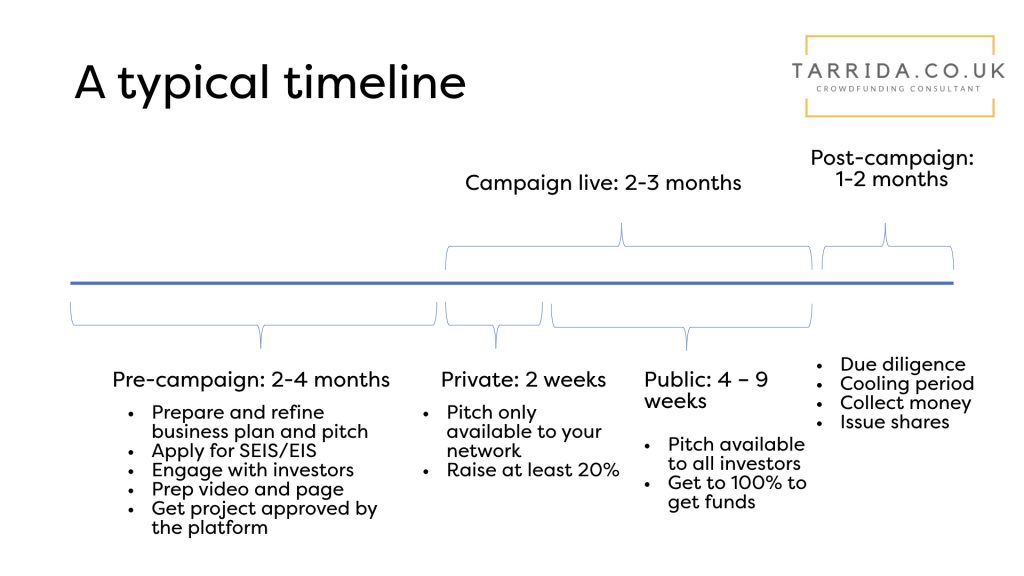You might be wondering how long is a typical timeline for an equity crowdfunding campaign. Let’s take a detailed look at it!
tl ;dr it takes 6 to 8 months, from starting to plan an equity crowdfunding campaign to having the money in the bank.
Let’s break it down
To understand how long your campaign is going to take, let’s take a look at its components one by one.

Pre-campaign
In this phase, we’re getting ready for the campaign. We produce the key documents, video and apply for tax schemes such as SEIS and EIS. Perhaps more importantly, at this stage we build a community of investors, warming them up and getting them ready to invest early, so we can show momentum in the campaign. This is crucial for investors that don’t know us: without momentum, they won’t feel compelled to invest along with our crowd. Your main tool in this phase will be a landing page. We discussed all of this in more detail in the article 7 steps to prepare your equity crowdfunding campaign. If you need to approach new investors with an email, here’s a template for you. And if you need a checklist for your tasks on pre-campaign, here’s one.
I can’t emphasise this enough. The pre-campaign is the most important phase of the campaign! If we don’t do a good job here, we will not succeed, as simple as that! That’s why I recommend my clients to take as much time as needed here. If they have a strong community and a few lead investors, it could take as little as two months. But more often than not, that’s not the case and more typically we spend about 4 months (sometimes more!) in this phase of the process.
Campaign
We subdivide this phase in two: private live and public live. Here’s a list of tasks during the campaign.
Private live
In this phase, you will have a link that you’ll be able to share with your network to let them invest the first.
You can decide when to go ‘public live’, but the platform will ask you to reach at least 20% of your campaign objective before showing your campaign to the rest of the platform investor community. I recommend my clients to go up to at least 40%. We will discuss why in more detail in a future article. For the moment I will only say: “no one wants to eat in an empty restaurant”.
This phase can be quite short, but in my experience, it’s worth taking your time and maximise the amount raised before going public, even if this extends your campaign.
Public live
It’s the moment of truth. You need to reach 100% of your objective to collect the funds! Typically, you can set this period for 30 to 60 days. Let me tell you though that it’s an exhausting period, with calls from and to investors, managing the forum, releasing updates… I would advocate to spend a bit more time on the pre-campaign and private live and minimise this period as much as possible.
There are countless examples of companies that have extended their public live period, in agreement with the platform, but I wouldn’t recommend it as it doesn’t look very professional.
Post-campaign
All things going well, you’ll have achieved your objective during the public live stage. Now surely the platform will release the money to your account, right? Not so fast!
You have to legally allow a cooling off period for your investors to withdraw their pledges if they get cold feet. The platform also performs their own due diligence, reconcile and collect the money, inform you of how many shares to issue and to whom and then proceeds to do so. Also, you should be issuing SEIS/EIS certificates to your investors if you were offering the scheme. In the smoothest of the campaigns, this will take around 4 weeks, but it’s rarely the case – more often than not it takes around 2 months.
Wrapping it up
So, let’s do some maths to see how long a typical timeline for an equity crowdfunding campaign is: on average you’ll spend 3 months on pre-campaign, 2 months live and at least 1 in post-campaign. That’s an optimistic calculation, and rarely all of the stages of the campaign run completely smoothly, hence the initial conclusion of 6 to 8 months.
Thanks for reading and as always, please do let me know if you have any questions, points to expand on etc. by commenting on this post or through the form at Contact me.


Leave a Reply